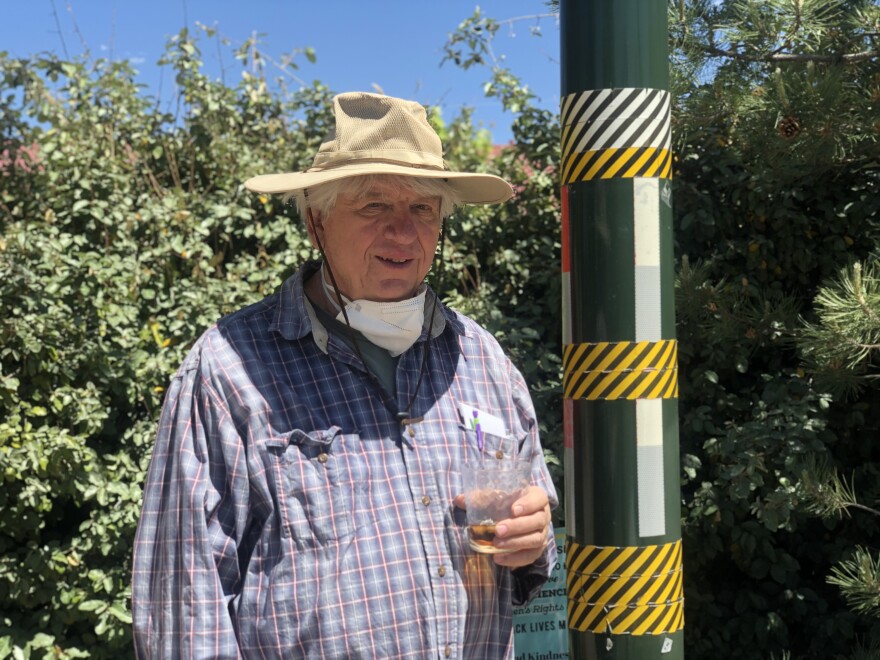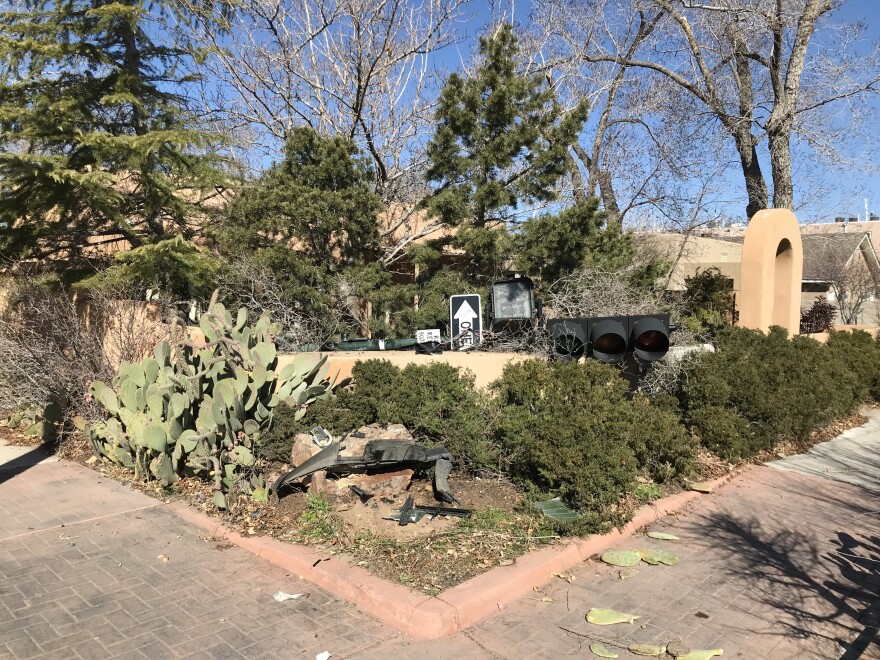Neighbors along the Lead Ave. and Coal Ave. corridor in southeast Albuquerque say they have a unique problem: cars regularly crashing into their homes and yards. After the ART bus project reduced lanes on adjacent Central Ave., they say their residential thoroughfare is busier than ever.

Bob Anderson has lived off of Coal Ave. in Albuquerque’s Nob Hill neighborhood for about 17 years. He’s gotten used to the sound of car crashes outside his home. “We hear these big thuds here, and crashing, and the sounds of glass breaking and metal bending,” he said. “Tires will be screeching and then sometimes we’ll hear people holler and shout ‘help’ or something like that.”
Anderson says he’s had five crashes onto his property over the years and maybe more, since he sometimes comes home to car parts strewn about. He walked around his front yard recalling some of them: a car with children that had busted through his wall, two cars spun around backwards into his yard, one taking out a tree. He pointed to a spot on the outside of his wall where he has a small garden. “I almost got killed right there,” he said. “I was standing there trimming the weeds and I heard this crash,” he recounted. “I turned around and looked, and the guy’s bumper stops about an inch from my leg.” He says he hasn’t felt as comfortable working out front since.
Anderson isn’t the only one along Lead Ave. and Coal Ave. from Washington St. to Yale Blvd. to have crashes into his property. “Just my little area here is chaos; cars crashing all the time,” he said. “The house right down there on the corner had to build a wall of railroad ties out in front of their house.”

Creative barricades like that aren’t uncommon. Joseph Aguirre lives a few blocks away on Lead Ave. in the University Heights neighborhood. For over three years, he’s headed up the Lead Coal Safety Brigade, a group of concerned neighbors calling for action. He installed several large boulders on his corner to help prevent cars crashing into his property, though several have anyway. One knocked the traffic light down. “This entire post was displaced and tossed into our yard,” he said, pointing to the traffic signal pole. “And, you know, that’s all very dramatic,” he added, “but if anyone had been on this corner, it would have been horrible.”

Aguirre has tracked the numerous crashes along the corridor over the years as part of his effort to organize for change. He’s compiled an extensive collection of harrowing wreck photos – including a city bus that crashed into a home in 2015. “Block after block of cars onto sidewalks, cars into yards, an ejection fatality in front of living room windows,” he recounted. “I mean, these are horrible collisions.”
Aguirre sat on a city task force established in 2018 to address the issue, led by the Albuquerque Municipal Development Department (DMD).
A 2019 report from the group says the corridor sees more crashes than other, comparable roads with 528 wrecks from 2014 to 2017. The report doesn’t list the number of fatalities or injuries, or how many wrecks ended up on private properties. However, it does show that the homes on Lead and Coal are set much closer to the street: only 25 feet. That’s compared to 40 feet on similar roads. DMD Director Pat Montoya says that’s an important factor. “When you’ve got property so close to the roadway,” he said, “the chances are much greater that it’s going to hit a home.”

Recognizing speeding as part of the issue, in 2019 the city reduced the timing of the corridor’s green lights and posted signs letting drivers know that they’ll hit all greens if they drive at 30 mph. However, a follow-up study to see if these efforts were successful was delayed from April 2020 until next February due to the pandemic. A department spokesperson admitted a recent informal speed analysis showed cars are still driving too fast, and it's clear more needs to be done.
Aguirre with the Lead Coal Safety Brigade agrees but says that a study isn’t necessary to see that the light and signage measures are insufficient. “That [2019] measure alone is out-of-scale for the size of the problem that we’re dealing with,” he said. “So, I think there’s every reason to move forward with a comprehensive set of measures.”
In the spring 2021 newsletter, The Nob Hill Neighborhood Association’s Quality of Life Chair, David Garcia, suggested additional safety measures, including lowering the speed limit to 25 mph and turning Lead Ave. and Coal Ave. into two-way streets.
But DMD director Montoya says both of those changes could actually increase speeding and crashes rather than curb them, and that the department doesn’t support either. He said that could change if a study confirmed they’d make a measurable difference. “We run a risk,” he said. “I mean, if a study is conducted and it shows all of these improvements, and we don’t take the initiative to do it, someone can come back and sue the city and say, ‘you knew about it. You knew if you did this, this wasn’t going to happen. You let it happen.’”
Montoya said the city would implement any measure within reason that the study scheduled for February recommends.
In the meantime, neighbors along Lead and Coal Aves. are left waiting behind makeshift barricades for the city to take action on a dangerous problem they say is as prevalent as ever.


